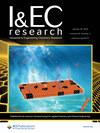Role of Pellet Geometry Controlled by 3D Printing on Catalytic Performance of Mn–Na2WO4-Based Systems in Oxidative Coupling of Methane
IF 3.8
3区 工程技术
Q2 ENGINEERING, CHEMICAL
引用次数: 0
Abstract
Pellet catalysts dedicated to oxidative coupling of methane (OCM) were prepared with the assistance of 3D printing technology using the casting technique. In this approach, polymeric templates printed using digital light processing technology were applied for pellet catalyst shaping. Three series of cubic-type catalysts varying in external size and number of channels were produced by a one-step procedure of the templates filling with the paste containing Mn2O3, Na2WO4, α-Al2O3, and sodium silicate solution. The pellets containing 2 wt % of Mn2O3 and 5 wt % of Na2WO4 were characterized by X-ray fluorescence, X-ray diffraction, UV–vis diffuse reflectance, temperature-programmed reduction with H2, scanning electron microscopy–energy-dispersive X-ray spectroscopy, and X-ray photoelectron spectroscopy techniques and tested in OCM. The pellet catalysts exhibited excellent catalytic performance and stability vs time on stream. It has been found that the size of the pellets and their geometry have an impact on the catalytic performance and pumping resistance through the catalyst bed (drop pressure).

三维打印控制的颗粒几何形状对基于 Mn-Na2WO4 的系统在甲烷氧化偶联过程中催化性能的影响
在三维打印技术的帮助下,利用浇铸技术制备了甲烷氧化偶联(OCM)专用颗粒催化剂。在这种方法中,使用数字光处理技术打印的聚合物模板被用于颗粒催化剂的成型。通过在模板中填充含有 Mn2O3、Na2WO4、α-Al2O3 和硅酸钠溶液的浆料,一步法制备出了三个系列的立方型催化剂,其外部尺寸和通道数量各不相同。含有 2 wt % Mn2O3 和 5 wt % Na2WO4 的颗粒通过 X 射线荧光、X 射线衍射、紫外可见光漫反射、H2 温度编程还原、扫描电子显微镜-能量色散 X 射线光谱和 X 射线光电子能谱技术进行了表征,并在 OCM 中进行了测试。颗粒催化剂表现出优异的催化性能和稳定性。研究发现,颗粒的大小及其几何形状对催化性能和通过催化剂床层的泵送阻力(下降压力)有影响。
本文章由计算机程序翻译,如有差异,请以英文原文为准。
求助全文
约1分钟内获得全文
求助全文
来源期刊

Industrial & Engineering Chemistry Research
工程技术-工程:化工
CiteScore
7.40
自引率
7.10%
发文量
1467
审稿时长
2.8 months
期刊介绍:
ndustrial & Engineering Chemistry, with variations in title and format, has been published since 1909 by the American Chemical Society. Industrial & Engineering Chemistry Research is a weekly publication that reports industrial and academic research in the broad fields of applied chemistry and chemical engineering with special focus on fundamentals, processes, and products.
 求助内容:
求助内容: 应助结果提醒方式:
应助结果提醒方式:


